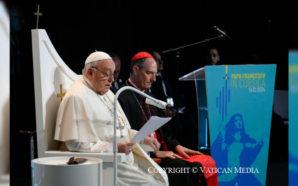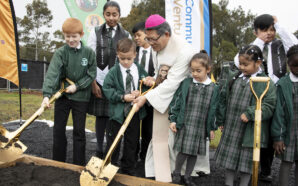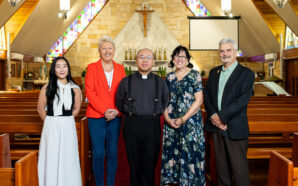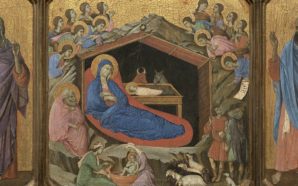Homily for the 32nd Sunday in Ordinary Time
17 November 2024
Readings: Daniel 12: 1-3; Psalm 15; Hebrews 10:11-14,18; Mark 13:24-32
As if to match our feelings of apprehension for our world as Donald Trump announces some left field appointments to his Cabinet, today’s gospel is an extract from Mark’s eschatological discourse in Chapter 13, warning us of dire things to come. We know there is going to be a lot of disruption. If you are a Ukrainian, or a Palestinian living in Gaza or on the West Bank, you have reason to fear that the sun is darkening, the moon is losing its brightness and the stars will come falling from heaven.
Listen to the full homily on SoundCloud.
For us Christians, no matter what the gloom and doom of our world or personal circumstances, we live with hope – the hope described in the gospel with the colourful imagery of the Son of Man coming in the clouds with great power and glory. In today’s second reading from Hebrews we are told that Christ ‘has offered one single sacrifice for sins, and then taken his place forever, at the right hand of God’. This imagery is all a bit much for many of us. But it does convey the hope that Jesus has once and for all transformed our lives and our world, ultimately, no matter what the present fragile state of despair. That’s why we persevere; that’s why we come to the eucharist on a Sunday, breaking open the word and breaking the bread.
During the week, I launched a book by the highly personable, urbane, well educated Anglican priest Scott Cowdell entitled ‘Why Church? Christianity as It was Meant to Be. Scott was delighted to have the opportunity to spend time with a parish youth group giving talks on a whole range of his interests from ethics to creation belief to the Zen-like parables of Jesus in the gospels. Unsurprisingly he found the young people very appreciative and wanting for more. So he invited them to come to church on a Sunday. The response: ‘But the Sunday Eucharist in that family sized congregation, with people who loved them and had known some of them all their lives, was a different matter.’[1] Young people could ‘think the thoughts and value the insights, and even own the Christian faith to some extent, though without much sense of attraction let alone obligation toward the Church and its Eucharist. Why?’ That’s the crunch question.
Looking for answers, Scott distinguishes church as hardware from church as software. Historically the church as hardware provided us with the entire package. During the time of the Roman Empire, the church as hardware ensured a vast Christian expansion. As Scott says, ‘The church’s radically new values and practices were the necessary vector of Christian faith’s eventual ascendancy in the Roman world.’[2]
The church as software is the church of many options which for us Catholics is often described as ‘cafeteria Catholicism’. Being one who usually prefers an a la carte choice rather than the set menu, there is much I find attractive about the church as software. Incidentally, I find nowadays that the Catholics most supportive of a Church as hardware during the pontificates of John Paul II and Benedict XVI are now the very ones wanting a Church as software, being free to put aside some of Francis’s teachings about climate change and the poor.
The philosopher Charles Taylor has observed: ‘For many people today to conform to some external authority just doesn’t seem comprehensible as a form of spiritual life.’[3] Given our software choices particularly as they were expanded during the COVID pandemic, why would one as a matter of choice go to church rather than simply staying at home or consorting with one’s likeminded fellows appropriating the teachings and the practices which one might find attractive?
Scott takes the example of children being asked to eat broccoli, something equivalent to asking teenagers to attend church. ‘If western churches play today’s subjective spiritual impulse, they risk being outdone by something more personally amenable that delivers satisfaction more reliably. And when worship is dull, unconvinced, uninspiring, and all the other disappointing things that typify many mainstream congregations, it will not do to tell people that it is still somehow good for them to be there. This is like telling children that eating broccoli is good for them – it is unlikely to provide the requisite motivation.’ Here is Scott’s bold claim: ‘What works is the change of perspective that faith brings, which needs to be evoked so that people are awakened to the presence of something compelling. If you must be a committed vegetarian or vegan to welcome the sight of plain steamed broccoli, … likewise, the dawning of faith through encountering Jesus Christ in his gospel is what will open minds and hearts to the Church.’[4]
As I read this, I contemplated the scene in my Brisbane parish recently when we had a full church of very enthusiastic children making their confirmations. Nowadays as you would realise it’s not just the children but also the parents who lack a familiarity with the contours of the liturgy. However with the use of an overhead projector and a rousing choir, people can be invited to participate in a liturgy which is full of life. At the end of this particular celebration the children lined up on the steps of the sanctuary with us two clerics who had performed the confirmations. The church was abuzz. The children were over brimming with joy. As the photographer completed his task, two children in front of me turned to each other and one said with great joy: ‘This is great; we don’t have to come to mass again’. As a parish we’ve done all you could possibly hope in providing training in the faith and an introduction to the liturgy not only for the children but also for their parents. I’m not expecting to see those two children or their parents at Church for some time to come.
Scott writes beautifully about the watermarks of the church – those watermarks being one, holy, catholic and apostolic. He says watermarks are permanently there even if not always obvious. Scott envisages the church as a non-tribal tribe. He espouses a high bandwidth catholicity. With another delightful culinary reference, he sees catholicity ‘as having a firm centre but soft edges – like al dente pasta’[5]. Regarding the softness at the edges, he endorses Anglican comprehensiveness in being able to tolerate a measure of ambiguity and untidiness.
Scott quotes from the liturgy of Saint James:
Let all mortal flesh keep silence
and with fear and trembling stand;
ponder nothing earthly minded,
for with blessing in his hand
Christ our God to earth descending
comes full homage to demand.
Why church? What is asked of us to respond with full homage? The ultimate sticking point for so many of us nowadays is ‘accepting institution, authority, and power in the Church as part of being Christian’ wondering how this could be compatible with ‘today’s high premium placed on autonomy’.[6]
Nowadays some think that they can provide full homage by availing themselves of the church as software, particularly with alternative versions of church which can be found online or in virtual reality. Scott does not think this provides an answer though he insists that we must always demonstrate pastoral generosity to those who take that path. He obviously has great sympathy with those clergy who have encountered great disappointments with their own church but who stick with it noting that ‘if you get seasick, you should not seek a berth too near the engine room’.[7]
Describing the spiritual journey and the relevance of the institutional church, Scott acknowledges that ‘Jesus’s desire to share the Passover with us in the Eucharist, and to enlist us in the world and life transforming Christian adventure through the church’ is more objective and more foundational than a personal software quest for individual benefits.
I recommend his book. Incidentally, Scott has now become a Catholic.
Coming to the table of the Eucharist, we give thanks that despite our failings and our despair at the state of the world, by virtue of this one single offering we celebrate and remember together, Jesus has achieved the eternal perfection of all whom he is sanctifying. It is no delusion for us to leave church each Sunday with a spring in our step, no matter what. We pray:
Keep us safe, O God; you are our hope.
O LORD, it is you who are my portion and cup;
it is you yourself who secure my destiny.
I keep the LORD before me always;
with him at my right hand, I shall not be moved.
Keep us safe, O God; you are our hope.
And so, my heart rejoices, my soul is glad;
even my body shall rest in hope.
For you will not abandon my soul to Sheol,
nor let your faithful see corruption.
Keep us safe, O God; you are our hope.
You will show me the path of life,
the fullness of joy in your presence,
at your right hand, bliss for ever.
Keep us safe, O God; you are our hope.
[1] Scott Cowdell, Why Church? Christianity as It Was Meant to Be (Church Publishing, 2024) 1
[2] Ibid 14
[3] Ibid 37
[4] Ibid 99-100
[5] Ibid 101
[6] Ibid 128
[7] Ibid 130








